
Airfix 1/600 HMS Argonaut
| KIT #: | ? |
| PRICE: | $ |
| DECALS: | perhaps |
| REVIEWER: | Frank Spahr |
| NOTES: | As she was on May 22, 1982 |

| HISTORY |
21 May, 1982 was D-day in the British campaign to repossess the Falkland Islands, seized by Argentine forces on 2 April that year. All available warships, especially both remaining carriers, and a large and motley collection of civilian vessels „taken up from trade“ had been deployed south in all haste to - if possible anyhow - complete the operation before the antarctic winter set in.
Both dedicated amphibious vessels HMS Fearless and Intrepid, plus the five amphibious support vessels named after knights of the round table, as well as several car ferries and the liner SS Canberra crowded in the narrow anchorage of San Carlos Water on the west coast of East Falkland. As long as no SAM batteries had been set up by the embarked troops, air defence for the amphibious ships and the beachhead were provided by a number of frigates of various types, patrolling the Falkland Sound and San Carlos water. Amongst them were the two precious and irreplaceable Type 22 with their Sea Wolf short range SAM, but also several older vessels.
 One of them was the
Batch 2 Leander Class frigate HMS Argonaut, deployed to patrol the
entrance to San Carlos Water between Fanning Head and Chancho Point. She was
equipped with three Sea Cat SAM launchers and two single 40 mm Bofors AA guns
for air defence.
One of them was the
Batch 2 Leander Class frigate HMS Argonaut, deployed to patrol the
entrance to San Carlos Water between Fanning Head and Chancho Point. She was
equipped with three Sea Cat SAM launchers and two single 40 mm Bofors AA guns
for air defence.
Although the Argentines did not notice the arrival of the British ships during the night, they became aware of the landings at daybreak and soon started counter-attacks. The narrow San Carlos Water with its surrounding mountains limited radar range - approaching planes could only be detected at very close range. And they attacked in many waves throughout this day, hitting all but two of the British warships present.
Argonaut was attacked by the very first Argentine plane arriving at the Amphibious Operating Area (AOA), a Macchi 339 firing a salvo of 5in rockets at her and strafing her with 30 mm cannon fire. One rocket hit the Sea Cat missile deck area, injuring three men. Despite heavy fire, the plane got away.
Later in the day, a formation of 5 A-4B Skyhawks swept in at very low level from the north, concentrating their attack on Argonaut, currently on the northbound leg of her patrol. No countermeasures could be taken, and two out of the five 1,000 lb bombs dropped hit the ship from port. The only damage to the Skyhawks was the tip of one of the external tanks of the leader, as it touched the ship's antennas while jumping over it. Luckily, the extremely low altitude they were released at kept the bomb´s fuses from arming, and neither bomb exploded. Nonetheless their impact caused serious damage: One bomb hit the forward Sea Cat magazine, causing two of the missiles to explode. Luckily the ensuing fire was drenched by cold diesel fuel from a ruptured tank, incredible as that may seem. The other bomb hit the bulkhead between the engine and boiler rooms, cutting down both motive power and steering immediately – right at a moment when the ship was moving with considerable way right towards the cliffs of Fanning Head.
The Officer of the Watch, Sub-Lieutenant P.T. Morgan, ran forward from the bridge, and assisted by two sailors he collected on the way, dropped an anchor, bringing Argonaut to a halt immediately ahead of the cliffs.
 During ongoing heavy
attacks on the AOA, the Plymouth secured alongside the Argonaut
and rendered assistance and electrical power to her, aiding her damage control
teams in urgent repairs. While two bomb disposal teams (one of which should stay
aboard for a whole week) were airlifted in and started work on the two bombs,
the frigate was towed deeper into San Carlos Water.
During ongoing heavy
attacks on the AOA, the Plymouth secured alongside the Argonaut
and rendered assistance and electrical power to her, aiding her damage control
teams in urgent repairs. While two bomb disposal teams (one of which should stay
aboard for a whole week) were airlifted in and started work on the two bombs,
the frigate was towed deeper into San Carlos Water.
The next day it was decided to move the frigate to another anchorage, and three of HMS Fearless´ LCU´s were selected for the task, which they completed amidst the multitude of other tasks these largest and most capable landing craft were needed for. Ewen Southby-Tailyour´s book „HMS Fearless“ contains the only reference and picture to this tow.
Anchored in the entrance to the water, Argonaut was still immobile yet could assist in air defence as most of her weapons were operational. On 24 May repairs had proceeded so far that she could at least move on one set of machinery. She remained in the AOA which was frequently under attack; only on 28 May could the bomb from the Sea Cat magazine be removed. The team that had removed the bomb from the boiler room had completed that task within a day and had proceeded to HMS Antelope, sadly one of them was killed and another seriously injured when the bomb they were trying to defuse exploded.
Only on 30 May was Argonaut sufficiently patched up to leave San Carlos Water which she did escorting two LSL´s. Before her return home, more repairs were performed by the team of the repair ship Stena Seaspread. She finally returned to Devonport on 26 June.
Of the warships that entered San Carlos Water on D-day, only the old frigate Yarmouth remained undamaged. All others were hit by the Argentine, with the two Type 21 Ardent and Antelope being lost. San Carlos Water was soon nicknamed „Bomb Alley“ by the British and „The Valley of Death“ by the Argentine that suffered heavy losses in planes and pilots in the attacks.
The Ship
 The Leander Class is
regarded as the most successful British postwar class of warships, with 26 units
built in three batches from 1960 to 1973, and serving into the early 1990ies.
Batch 1 was designed as a general purpose frigate, Batch 2 primarily for ASW
purposes, and Batch 3 had a broader beam by 2 ft, making them more stable and
suitable for modernization. Each batch had a different powerplant, in fact they
were the last frigates with steam power plants.
The Leander Class is
regarded as the most successful British postwar class of warships, with 26 units
built in three batches from 1960 to 1973, and serving into the early 1990ies.
Batch 1 was designed as a general purpose frigate, Batch 2 primarily for ASW
purposes, and Batch 3 had a broader beam by 2 ft, making them more stable and
suitable for modernization. Each batch had a different powerplant, in fact they
were the last frigates with steam power plants.
Originally armed with a twin 4.5in mount, nearly all vessels lost their gun turret in refits. Some received the Ikara ASW missile system, the others were equipped with four Exocet sea skimming anti-ship missiles. Originally equipped with the Sea Cat SAM, on five of the Batch 3 vessels the Sea Wolf SAM system was retrofitted. Other modifications to ships of the Leander class were:
- Enlarging the hangar for the original Wasp helo to house the more capable Sea Lynx
- Plating over the stern well for the Limbo ASW mortar to enlarge the flight deck
- Adding VDS to the stern (though some vessels were constructed with it)
|
Specifications (Wikipedia) |
|
|
Dimensions |
372 ft (113 m) x 41 ft (12.5 m) Batch 1 and 2, 43 ft (13.1 m) Batch 3 x 18 ft (5.5 m) |
|
Displacement |
2860 tons full load (Batch 1 and 2)/3000 tons full load (Batch 3) |
|
Machinery |
2 shafts, 2 steam turbines, 2 boilers, 25,000 shp (19 MW) |
|
Speed |
28 knots (52 km/h) |
|
Armament |
2 twin mount x 4.5 in (114 mm) guns (later removed on five Batch 3. Removed in all Batch 1 and 2 ships) 2 x Bofors 40 mm guns (Later removed from Batch 1 and 2 ships. Also removed from five Batch 3 ships) 2 x Oerlikon 20 mm cannon (Batch 1 and 2. One x 20 mm gun later added to Batch 3 ships) Sea Cat anti-air missile launcher (Batch 1 and 2. Removed from five Batch 3s) Sea Wolf anti-air missile launcher (Five Batch 3 ships) Exocet anti-ship missile launcher (Batch 2 and five Batch 3s) Mk 10 Limbo mortar (Batch 1. Later removed from all Batch 2s and five Batch 3s) Ikara ASW missile launcher (Batch 1)
|
|
Aircraft |
1 Westland Wasp, later 1 Westland Sea Lynx on Batch 2 and 3 |
|
Complement |
257 |
|
Ships in class |
HMS Andromeda HMS Argonaut HMS Ajax HMS Achilles HMS Charybdis HMS Cleopatra HMS Arethusa HMS Apollo HMS Hermione HMS Danae HMS Aurora HMS Ariadne HMS Jupiter HMS Juno HMS Dido HMS Bacchante HMS Penelope HMS Minerva HMS Euryalus HMS Diomede HMS Scylla HMS Phoebe HMS Galatea HMS Sirius HMS Leander HMS Naiad |
|
|
|
Argonaut was modernized after the Falklands War, receiving a new VDS mounted on the starboard corner of her stern. In 1987 she once more made it into the news when she rescued media tycoon Richard Branson on an attempt at crossing the Atlantic in a hot-air balloon; in 1990 she took part in the ceremonies to commemorate the 75th anniversary of the Gallipoli landings. She served on until 1993, when she was decommissioned and scrapped in 1995.
| THE KIT |
This class isn´t
easily represented in any single model kit. Come to that, it´s not that well
represented in model form at all. To my admittedly limited knowledge there is a
1:96 R/C model by Sirmar and 1:1250 miniature, plus the venerable Airfix kit
first issued in 1970. I received this kit from the stash of a modeling friend
(thanks a lot, Norbert!) upon realizing my Falkland Warships Set
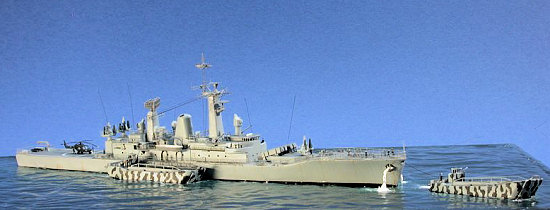 contained two
County Class destroyers but lacked the Leander. The kit depicts an early
Leander, with twin 4.5in turret, single Sea Cat, Wasp helo, Limbo well and stern
cutout for VDS. On the whole it looks less detailed and generally clunkier to me
than the Type 21 I had built before. I did no measuring whatsoever as I would
have lacked the skill to, say, elongate or shorten this or that part of her – I
had to make do with what I had.
contained two
County Class destroyers but lacked the Leander. The kit depicts an early
Leander, with twin 4.5in turret, single Sea Cat, Wasp helo, Limbo well and stern
cutout for VDS. On the whole it looks less detailed and generally clunkier to me
than the Type 21 I had built before. I did no measuring whatsoever as I would
have lacked the skill to, say, elongate or shorten this or that part of her – I
had to make do with what I had.
Getting helpful images of Argonaut during the time in question rendered scant results. Most of the images from the war I found were fairly grainy and did not show the questionable areas of the vessel. My best result was an image taken upon her homecoming to Devonport which is to be found at http://freepages.military.rootsweb.com/~cyberheritage/argo.jpg
I found a fairly informative image of Argonaut´s similarly modernized sistership Minerva in Friedman´s book on British destroyers. Moreover, I had received a CD with a large number of photographs taken on British ships during port visits over the years. Those showed a lot of details I really had no idea how to reproduce. Other sources were two very nice Leander class models at Yeovilton Fleet Air Arm Museum, although they show Argonaut as built and a broad beam Leander with Sea Wolf. So I had to make a list of what to change and which parts to procure to somehow get close to how Argonaut appeared when she was hit by the two bombs. I had bought resin Exocet launchers, Lynx helos and Sea Cat launchers, plus the applicable PE frets from WEM.
| CONSTRUCTION |
Norbert had at some point already waterlined the hull and glued the deck, so I didn´t have to start right at the beginning. I started with fitting the superstructure and trying to find out how to improve it. The model images were quite helpful in understanding what I could not glean from the ship photographs. Asking questions on modeling forums can be quite beneficial, too ;-)
 I started on an
impulse (like, sadly, so many things I do) by removing all molded on detail on
the fore deck, filling in the mounting hole for the turret. I also plated over
the Limbo and VDS wells using plasticard. This necessitated some filling and
sanding until I called it quits. During the inevitable delays I cleaned up the
superstructure, added the hangar extension from plasticard and reworked the ugly
bridge, replacing the bridge windows with appropriately sized PE ladder stock.
The much oversized splinter sh
I started on an
impulse (like, sadly, so many things I do) by removing all molded on detail on
the fore deck, filling in the mounting hole for the turret. I also plated over
the Limbo and VDS wells using plasticard. This necessitated some filling and
sanding until I called it quits. During the inevitable delays I cleaned up the
superstructure, added the hangar extension from plasticard and reworked the ugly
bridge, replacing the bridge windows with appropriately sized PE ladder stock.
The much oversized splinter sh ield astern the bridge was removed, too. The
bridge wings´ splinter shields were thinned out with a steel bur. I also added
a new deckhouse I had believed I could identify atop the hangar and right astern
the main mast, also from plasticard.
ield astern the bridge was removed, too. The
bridge wings´ splinter shields were thinned out with a steel bur. I also added
a new deckhouse I had believed I could identify atop the hangar and right astern
the main mast, also from plasticard.
I had learned earlier on that WEM´s 1:600 scale Exocet launchers were way overscale, so I used the Airfix ones. BTW, the Airfix instructions have you simply glue the Exocet launchers instead of the turret ...
True to tradition, I
managed to botch something I had felt I had really thought through. I test-fit
the launchers to determine the appropriate height, added some sheet supports to
get them a bit higher, and then glued them at an inward angle as I had seen and
done it on the Type 21. Then I set out to build the additional small angled deck
ahead of the launchers where the additional Sea
 Cat launcher had to be mounted
(the one whose magazine was hit by the bomb). I first cut the parts from paper,
and trimmed them until I was satisfied. Then I transferred the shape to
plasticard and cut it to shape. When I had completed this task, I sent images to
a friend of mine, who, being at a distance from the project, saw it unbiased and
informed me that the angle of the launchers seemed incorrect. He even added a
plan. Looking at the plan I also developed doubts, and re-examining my images I
had worked from I found he was perfectly right. Luckily I was able to remove and
reglue the launchers without more ado, and now it even looked as though an
Exocet might be fired without removing the Sea Cat launcher. Blast shields and
covers were added from plasticard and scrap PE.
Cat launcher had to be mounted
(the one whose magazine was hit by the bomb). I first cut the parts from paper,
and trimmed them until I was satisfied. Then I transferred the shape to
plasticard and cut it to shape. When I had completed this task, I sent images to
a friend of mine, who, being at a distance from the project, saw it unbiased and
informed me that the angle of the launchers seemed incorrect. He even added a
plan. Looking at the plan I also developed doubts, and re-examining my images I
had worked from I found he was perfectly right. Luckily I was able to remove and
reglue the launchers without more ado, and now it even looked as though an
Exocet might be fired without removing the Sea Cat launcher. Blast shields and
covers were added from plasticard and scrap PE.
Nonetheless the Sea
Cat looked oversize to me, an impression that gained weight when I test fit the
other two launchers to the hangar roof. I still don´t know what is correct, but
whereas the launcher had looked correct to me on the Type 21, it looked out of
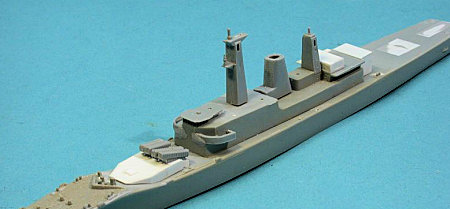 scale on Argonaut. As I felt unable to produce a smaller item, I decided
I had to live with it.
scale on Argonaut. As I felt unable to produce a smaller item, I decided
I had to live with it.
Next came corrections to the decks. I added deck extensions to the areas where the 40 mm Bofors guns and the Corvus chaff launchers would go. Working from what plans and images I had, I added watertight doors (from WEM) and drilled out scuttles to the superstructure.
Other items to make were the Corvus chaff launchers. These were built from stretched sprue and styrene rod. I would have liked to replace the lumpy Bofors with resin parts yet could not obtain those, so I ordered WEM´s PE fret for Bofors guns. I pretty soon realized I would be utterly and completely unable to work with these microscopic parts, so my expedient was to replace the barrels with pieces of syringes and add some PE to make the mount slightly more interesting. The triple torpedo tubes were made from a styrene base and cut to length pieces of syringes. The two directors received PE handwheels covered with white glue to somewhat improve their looks.
Making the LCU´s
 The LCU´s from the
Airfix HMS Fearless kit are actually really nice, save a major sink mark
on the rear front of the wheelhouse. I made some copies of one assembled LCU
using dental silicone and resin. These were cleaned up and somewhat improved
with PE railings, watertight doors and bridge
The LCU´s from the
Airfix HMS Fearless kit are actually really nice, save a major sink mark
on the rear front of the wheelhouse. I made some copies of one assembled LCU
using dental silicone and resin. These were cleaned up and somewhat improved
with PE railings, watertight doors and bridge windows. The LCU´s were primed
with Model Master enamel primer and painted as the ship, but with the addition
of the distinctive black tiger stripes applied to Fearless´ LCU´s.
Weathering was done using artist´s oil paints.
windows. The LCU´s were primed
with Model Master enamel primer and painted as the ship, but with the addition
of the distinctive black tiger stripes applied to Fearless´ LCU´s.
Weathering was done using artist´s oil paints.
Making the Base
Quite early on, I
had started on the base, using a picture frame filled with plaster cast against
a crinkled sheet of aluminum foil. The plaster having dried, I placed the models
on it, traced their outlines with a pencil and started removing plaster. The
frigate
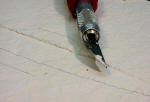 would have to have some list to starboard, and the LCU´s would have to
be worked into the base for a few millimetres. That done, the base was painted
using several shades of blue and green,
would have to have some list to starboard, and the LCU´s would have to
be worked into the base for a few millimetres. That done, the base was painted
using several shades of blue and green,
 with the disturbed water around the
vessels being greener and lighter and the surrounds darker. The image showed
water spouting from several sources around the ship´s bow, even from her
hawsepipes, so I added lighter areas of water where the water would hit the
surface of the sea. After drying, the so far flat paint was heavily sealed with
gloss coat from a big rattle can, and I was ready to continue.
with the disturbed water around the
vessels being greener and lighter and the surrounds darker. The image showed
water spouting from several sources around the ship´s bow, even from her
hawsepipes, so I added lighter areas of water where the water would hit the
surface of the sea. After drying, the so far flat paint was heavily sealed with
gloss coat from a big rattle can, and I was ready to continue.
| COLORS & MARKINGS |
Quite early on, I started painting. Again, the steel decks were painted JPS Acrylic IJN Maizuru Grey, a close match for the Dark Admiralty Grey used (in enamels, this would be WEM Colourcoats M 16) and the weatherworks using a homemade brew based on JPS RAL 7035 Lichtgrau (with enamels, use Light Weatherwork Grey Colourcoats M 01) This time, the entire ship was primed with enamels using Model Master´s trusty Grey Primer. So I could check for flaws and make sure the acrylics stuck well with the rather old and soapy styrene.
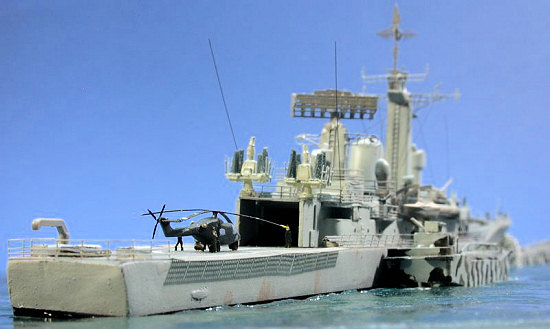 In this project, I
tried a new approach to painting. Recently, I had discussed how to reproduce the
oftentimes very visible stressed skin effect on modern vessels with some
knowledgeable and veritable modeling friends. Looking at the abovementioned
image of the homecoming Argonaut with the hull being anything but flat and
uniform, I decided I would give it a try.
In this project, I
tried a new approach to painting. Recently, I had discussed how to reproduce the
oftentimes very visible stressed skin effect on modern vessels with some
knowledgeable and veritable modeling friends. Looking at the abovementioned
image of the homecoming Argonaut with the hull being anything but flat and
uniform, I decided I would give it a try.
So I got a surplus piece of anti-insect netting and taped it to the already painted hull. I then gently sprayed a darker shade of grey (FS Neutral Grey), removed the mask and immediately disliked the result. So I sprayed the original hull shade over the revolting checkerboard and found that the more subtle it looked, the better. I stopped when the pattern was just visible yet didn´t stand out – and I´m quite pleased with the result.
Next came more detail work, painting the various additional items and also painting the superstructure. During this process, I cut masks and sprayed the flight deck markings. Working with acrylics made that a very fast process, as generally acrylics in my case tend to noticably speed up building time. Then I could glue the superstructure to the hull.
| FINAL CONSTRUCTION |
Modern warship´s masts are models to themselves, even more so if you work with good PE. I started by filling and sanding the masts, then very slowly and methodically added piece after delicate piece of PE, oftentimes cursing (not always under my breath), now and then inadvertently bending a freshly installed piece, now and then taking some time to make head and tail of how to mount this or that piece. But in the end it was done as far as I felt able to do it.
I had to replace the
single bedstead Type 956 radar antenna by an even more delicate one from WEM´s
1:700 Modern RN Radar  Set on the advice of fellow modeler Michael Potter from
MW.com. who pointed out that the 1:600 item was overscale. That assembly
consists of about a dozen parts, yet works really fine if you take your time.
After assembling the masts, they were sprayed hull colour, with the 956 antenna
painted in a slightly darker grey, based on my impression of the Devonport
photograph.
Set on the advice of fellow modeler Michael Potter from
MW.com. who pointed out that the 1:600 item was overscale. That assembly
consists of about a dozen parts, yet works really fine if you take your time.
After assembling the masts, they were sprayed hull colour, with the 956 antenna
painted in a slightly darker grey, based on my impression of the Devonport
photograph.
This was the time when things really started coming together; pretty fast Argonaut looked like a real ship. Having added the masts, torpedo tubes, chaff launchers (with shields), Bofors, Sea Cat launchers and directors, I then added davits from WEM´s Modern RN set, using the kit boats. The open boat received a cover made from white glue. I made an inflatable boat from styrene and white glue, plus a number of „boxes“ of different sizes from strip styrene. These were pre-painted and glued to various locations I felt they belonged to, especially on the stern, an area I knew next to nothing of, as all the available images showed Argonaut either as built or after the 1982 post-Falklands refit.
The kit liferaft containers were pretty clunky, so I tried to think of a way to better reproduce them. In the end I put a toothpick into my electrical drill, using it as a lathe, thinned it out and made grooves to somehow simulate a number of circular containers being stored next to each other. The result was painted and glued to a ledge made from scrap PE strip.
 The Lynx used is
WEM´s 1:700 resin item, and probably a bit on the small side, yet the only one I
had. It was cleaned up, painted in Sea Blue, with the PE rotors black with
yellow markings. The PE undercarriage was discarded and replaced by scrap
styrene.
The Lynx used is
WEM´s 1:700 resin item, and probably a bit on the small side, yet the only one I
had. It was cleaned up, painted in Sea Blue, with the PE rotors black with
yellow markings. The PE undercarriage was discarded and replaced by scrap
styrene.
Next came the addition of some serious amount of PE railings and some PE inclined ladders, which was not always a relaxed and hassle-free task, but done at some point. After the usual cleanup and touchups, I added a number of 1:700 Lion Roar crew figures, some stretched sprue rigging and a final enamel flat coat. Weathering was pretty minimal and achieved using thinned Vallejo acrylic paint.
After drying, I mounted the four vessels to the base using acrylic gel, added water spouts made from stretched clear sprue and acrylic gel, a towing cable made from stretched sprue, did some more touchups and called it quits.
| CONCLUSIONS |
This project was built from 25 September to 6 October, 2007, during a week of holidays without much else going on. I had less fun with it than with the Type 21, as the kit is inferior and I had too many issues with lack of information and scale discrepancies to be really comfortable. Nonetheless, it was fun enough and I like the rather uncommon sight of a frigate towed by LCU´s! The most welcome addition to my techniques is the stressed skin effect as it is frequently visible on modern, unarmored warships.
| REFERENCES |
http://en.wikipedia.org/wiki/HMS_Argonaut_%28F56%29
http://en.wikipedia.org/wiki/Leander_Class
http://freepages.military.rootsweb.com/~cyberheritage/argo.jpg
- Southby-Tailyour, Ewen: HMS Fearless, Barnsley 2006; ISBN 1-84415-054-2
- Friedman, Norman: British Destroyers and Frigates; London 2006; ISBN 1 86176 137 6
- Brown, David: The Royal Navy and the Falklands War; London 1989 (paperback); ISBN 0 09 957390 3
- Woodward, Sandy (with Patrick Robinson): One hundred days; Paperback edition with new preface by the author, Annapolis 1997; ISBN 1 55750 652 3
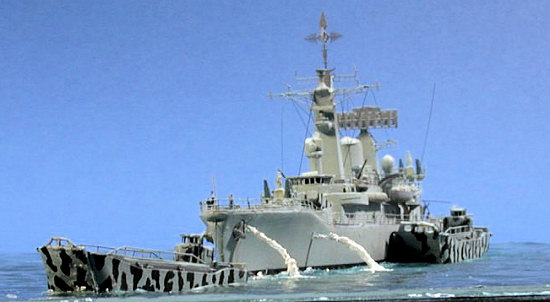 Material used:
Material used:
WEM 1:600 resin Seacat Launchers (currently not listed on the WEM website)
WEM 1:700 resin Westland Lynx (AS 7056)
WEM 1:600 „Ultimate“ Post War RN Set 1 and 2 (PE 624 and 625)
WEM 1:700 General Post War RN Set PE 700 (davits)
WEM 1:700 Post War RN Radars PE 701 (Type 956 Radar)
Thanks to:
- John Snyder and Peter Hall at WEM for their help with paint schemes
- Michael Potter for his input on VDS, armament and his hint on what radar to use
- Lars Scharff for reference material and always constructive criticism
- Norbert and Nadja Thiel of NNT mail order for providing the kit and helping out with urgently needed items in next to no time!
- Burkhardt Masch and Rainer Michalek for providing comprehensive images from their UK visit
October 2007
Copyright ModelingMadnes.com
If you would like your product reviewed fairly and fairly quickly, please contact the editor or see other details in the Note to Contributors.